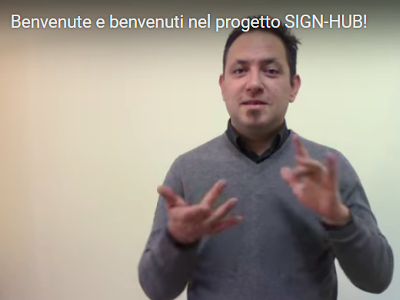For the first time Italian sign language (LIS), together with Catalan (LSC), Spanish (LSE), Turkish (TID), German (DGS), and the Netherlands (NGT) will have a complete grammatical reference system that will describe all linguistic phenomena: phonological, morphological, syntactic and pragmatic. It will be subject to diagnostic tests that access the language disorders, will have archives of linguistic and cultural memory thanks to video interviews with older signers and will be connected to others thanks to the first geographical Atlas of sign languages.
These are the main objectives of the SIGN-HUB, European project financed by the European programme of research and innovation Horizon 2020, destined to represent a real revolution for the international signing deaf communities. For Italy, scholars of the Ca’ Foscari University of Venice and Milan Bicocca are at work, working together with universities in Spain, the Netherlands, Turkey, Israel, France and Germany.
SIGN-HUB involves ten universities from seven different countries, at work on 6 grammatical systems of the sign languages. Through a comparative approach, the international research team aims to preserve and disseminate sign languages helping to delineate the faculty of human language more clearly.
The first national workshop was held at the Venetian University’s headquarters on 6th April 2018: “The contribution of Italian Unity to the SIGN-HUB project: first results”.
The final objectives of the project that the Italian researchers are working on at the same time as their international colleagues are to make a decisive impact on the teaching and learning of sign languages among deaf communities in many countries.
“SIGN-HUB is an ambitious project that systemises work on sign languages carried out in the last ten years in Europe thanks to the previous COST project, which is open to clinical issues, crucial to the improvement of a deaf person’s quality of life,” explains professor Anna Cardinaletti, Researcher at the Department of Linguistics and Comparative Cultural Studies at Ca' Foscari. “Deeper knowledge of language and culture of deaf communities encourages the integration between the two communities, deaf and hearing, and a common commitment to guarantee accessibility and inclusion.”
“Research on sign language at an international level has encouraged the recognition of these languages as minority languages,” said Professor Carlo Cecchetto, Professor at the University of Milan-Bicocca. “On a European level, Italy is lagging behind. The lack of recognition has negative effects on signing people, who often do not have the right to an interpreter at school, in hospitals, or at court. It also has a negative effect on non-signers who have fewer opportunities to come into contact with LIS culture.”
The first step will be creating the first grammatical reference system for sign languages from the countries involved, which will contain elements of historical-social context, phonology, morphology, syntax and pragmatics. But how do you write out a grammar of a visual-gestual, non-written language? It will be a digital and multimedia product, where the text will be accompanied by a video and images, accessible to deaf and hearing people and on the web platform SIGN-HUB.
Starting with a grammatical contents, the digital Atlas will be constructed for the sign languages, another important tool to know the linguistic properties of any language, widely used for vocal languages but still non-existant for sign languages.
There are new features on the medical-clinical level with the introduction of the first diagnostic tests to evaluate language disorders in sign languages. In the hearing populations, language disorders such as aphasia, specific language disorders, or learning disabilities such as dyslexia are diagnosed and treated. The researchers are waiting for similar language disorders that exist in deaf communities but to this day, specific tests haven’t been developed to diagnose if low-level linguistic performance in comprehension and production is due to a late learning of sign language (frequent in children born to hearing parents) or from actual speech disorders. The research groups are now carrying out the tests, which will be distributed by specialists, alongside LIS experts, to signers who have suffered brain damage, signers with neurodegenerative diseases at the initial stages, children with language difficulties, and to signers who don’t have linguistic disorders in order to determine the standard to refer to. The tests will consider variables such as the sociolinguistic situation of reference (for example, we refer to children born to hearing parents), thus paying attention to the age of linguistic acquisition.
In the cultural field the new feature will be the construction of visual archives in sign language made through collections of video interviews with elderly deaf people. Language is an important distinctive cultural element of a community and it is fundamental to preserve it. Deaf people are part of a minority linguistic community that was formed with a distinction from the majority, united by deafness. Sign language has become the central nucleus of this community.
The project will therefore allow the gathering of the first cultural and linguistic archive of sign languages in the deaf communities in which this project was realised, an important documentation of the history of the deaf community in Europe and a useful instrument to verify the linguistic diachronic change in languages at risk of dying out.
Chiara Branchini, part of the research team and a lecturer of Italian Sign Language at Ca’ Foscari, highlights how the work of this project of studying sign languages is important, “because it contributes to delivering deaf communities the crucial tools for promoting their cultural and linguistic identity with significant effects on their daily lives. Not only this, but studying sign languages means providing a valuable linguistic tool to the hearing community which is increasingly being used as the communication channel in syndromes (such as autism, down syndrome or dyspraxia) which are used when vocal language is impaired.”
International Website: www.sign-hub.eu
Italian Website: www.sign-hub.it with content available in Italian and Italian sign language.
Federica Scotellaro











